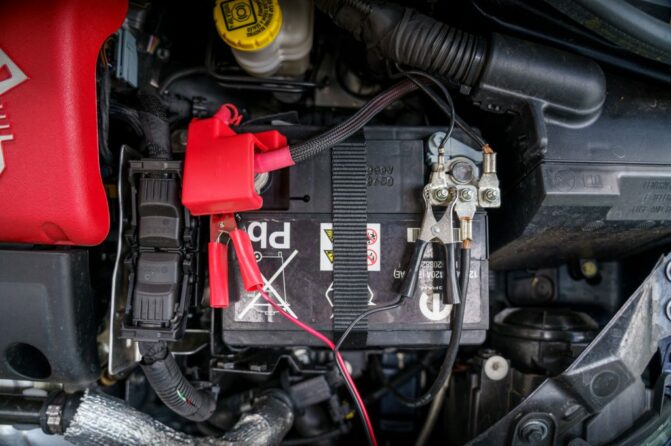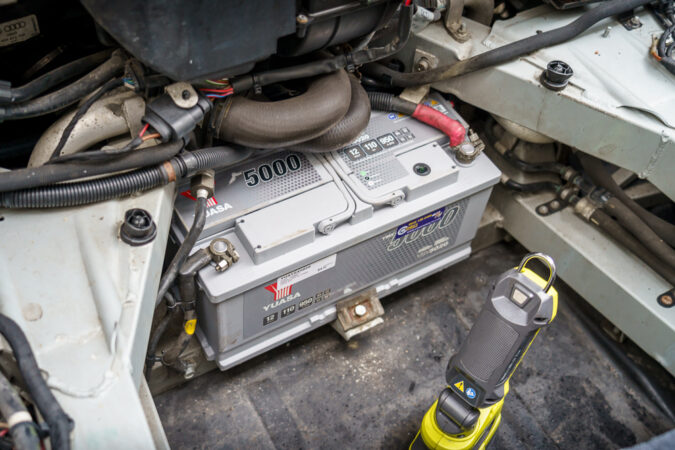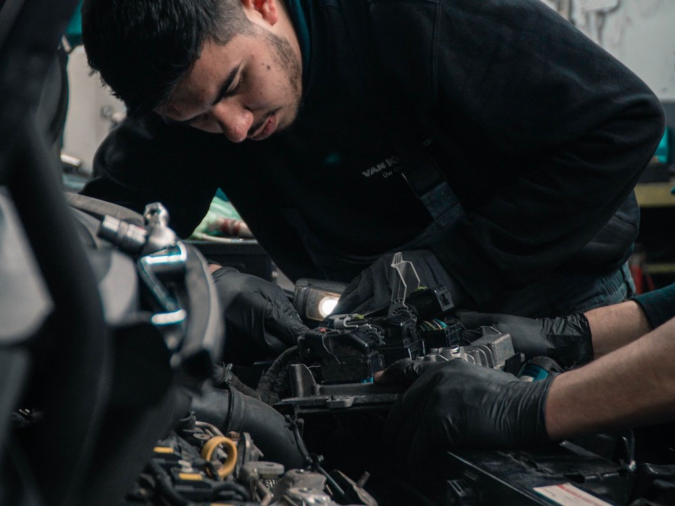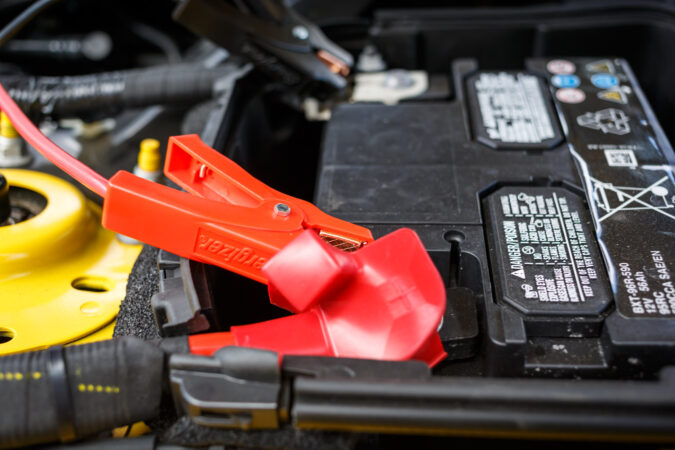All car batteries have two terminals; the positive and the negative terminal. Knowing which one to connect first and last between the two can damage your car’s electrical system and battery life. Also, if you don’t connect them in the correct order, you may damage your car battery and the entire electrical configuration of your car. Your question might be “positive or negative first when connecting a battery?”. Here is your answer.
The correct order is to connect the positive terminal first; then, the negative terminal connection comes after. This is because the negative terminal is permanently attached to the car’s negative frame, which is always grounded. You can only connect the negative terminal first if you have created a circuit between the chassis and the negative terminal before.
In addition, connecting the negative terminal first can cause sparks and damage your car battery and your car’s electrical system.
Battery Terminal
Your car battery terminal power your car’s electrical system by connecting to the positive and negative posts of the battery. A battery terminal’s main component is metal with high current conductivity. Most battery terminals are built from lead, but some new cars now use steel battery terminals.
Your car battery will have one of the following terminals;
- SAE Post: It has two lead posts that appear in a cone shape.
- JIS Post has two lead posts but is smaller than the SAE.
- Side Post Battery Terminals: It has two open threads where you will connect bolts and battery terminal adapters. Both negative and positive sockets have the same size.
- L terminals: It has an L shape and a hole in the vertical post. They are common with European cars, lawnmowers, and motorcycles.
- Stud: The positive and negative have the same size, but the diameter is different.
If you are using marine batteries, they have four posts, two threaded posts for positive and negative terminals, and two SAE posts. If you are having issues differentiating between positive and negative terminals, most car batteries are always labeled and have color codes too.
A plus sign (+) and red color indicate a positive terminal, while a minus (-) sign and black color indicate a negative terminal. Find the signs to determine each terminal if the color has washed off.
Car Battery Replacement
If you have been using your car battery for over three years, or you noticed that your car headlight is dimming, or you always jump-start your car because the battery is dead, it’s an indication that it’s time to replace your car battery. Unfortunately, manufacturers did not design batteries to function for life, so you need to replace them when due.
Whenever you need a new battery for your car (bearing in mind how much does a car battery cost and how to install a car battery, as well as the new car battery cost), contact your local mechanic or dealership to assist you, or you can do it yourself by following these simple steps;
Positive Or Negative First When Connecting A Battery: Step 1
Remove the old battery. Park your car in a cool, secure place free from traffic, flame, or water. Remove your key from the ignition, engage your parking brake, and ensure the engine is off. The best place to carry out this task is in the garage.
Positive Or Negative First When Connecting A Battery: Step 2
Open your car hood. You must put on insulated gloves and working goggles to protect your face and body. Car batteries contain a sulfuric acid electrolyte solution that is harmful and explosive; it can burn your skin if you don’t put on safety wear. Once you are done, open your hood with a rod.
Positive Or Negative First When Connecting A Battery: Step 3
You will find your battery close to the windshield or front bumper. Locate the rectangular battery box connected to two cables. If you can’t find your battery, check your user manual. Some vehicles always have their battery in the trunk.
Positive Or Negative First When Connecting A Battery: Step 4
Disconnect the battery. First, detach the negative cable and keep it somewhere with a cable tie. Removing the negative cable first will prevent electrical shock; once you remove the negative cable, keep it somewhere it can’t touch any metal. The wrench you will need to remove the cable depends on your type of vehicle; you won’t even need any wrench for some cars.
Now disconnect the positive cable and keep it somewhere it can’t touch any metal; also, make sure the negative and positive cables do not come in contact.
Positive Or Negative First When Connecting A Battery: Step 5
Get the battery out of the car. The battery is always inside a bracket, remove every connector holding it to the bracket and carry the battery out of the car, now place it on a dry surface. Make sure you have bought the correct battery.
Positive Or Negative First When Connecting A Battery: Step 6
Clean out the corrosion on the new battery; the terminals can have a powder substance that can appear in blue, gray, or white color, and clean it out with emery cloth or sandpaper.
Positive Or Negative First When Connecting A Battery: Step 7
Position the new battery into the bracket and attach every connector that will hold it firm to the bracket. Coat each terminal with lithium to prevent rust, and ensure the lithium did not spray on any part of the battery except the terminals. Ensure the battery sits well in the bracket so it won’t vibrate or move around while driving.
Connect the positive cable first, attach the cable to the terminal, and tighten it; lastly, cover the battery. Connect the negative cable to the terminal and tighten it with a wrench; make sure the cable or the wrench does not touch anything metallic.
Positive Or Negative First When Connecting A Battery: Step 8
Close your car hood and start your car. At this point, once you start your car, every accessory should begin to function, reset your clock, navigation system, and radio.
Battery Cables
The primary function of battery cables is that they establish an electrical connection between the car and the battery; they are mostly very durable because they are made from thick gauge copper wire. However, battery cables can rust and get damaged; at this point, you will need to replace them for the proper functionality of your vehicle and to prevent specific injuries.
The good news is that if you have the tools and follow the simple steps below, you can easily replace your car battery cables.
Typically, you connect two cables to the battery: the positive and the negative. The negative cable ensures the battery is grounded and attaches it to a grounded point. In contrast, the positive cable connects the battery, the starter motor, and the entire car’s electrical system.
Both cables have terminal ends that attach them to the cable. If your battery cable has rust, you need to clean the corrosion out, or else your engine will crank slowly or not start at all.
If you notice that your battery cables are damaged, first of all, run a physical inspection by checking the battery’s housing for damages; if you see any, replace the battery immediately. In cases when you can’t figure out the damages on your cable just by physical inspection, run a voltage drop test on the starting circuit instead.
How To Change Battery Cables
Replacing your car battery cable depends on your car’s year, make, and model. Check the user manual to see how to replace your battery cables. Below, you will find the information you need to replace your battery cables effectively.
First, you will need tools such as wheel chocks, jack and jack stands, safety glasses, gloves and goggles, and a wrench set. Below are the steps you should follow;
- Get a safety glass and glove and put them on.
- Raise your car with a jack stand and maintain the raised position with a jack stand to create more space.
- Detach the negative cable from the battery first, and ensure it does not come in contact with the battery.
- Detach the positive cable from the battery.
- Disconnect every connector holding the battery firm in the car.
- Remove all the connectors and battery hold-down devices from the car.
- Carry the battery out of the car
- Now that you have gotten the battery out, you will see how the cables connect to the battery.
- Detach every hold-down connector holding the cable to the car, and remove the cable from the engine system.
Disconnect Car Battery
Whenever you want to replace your car’s old battery with a new one, following a particular order in disconnecting the cables is very important. Following the order will prevent some electrical shock that can damage your battery and the cable. Disconnect the cables from the negative terminal first; the negative terminal will have a (-) sign, usually black.
Now disconnect the cables from the positive terminal; it usually has a (+) sign and is red. Make sure none of the terminals come in contact with any metal object.
Positive Or Negative First When Connecting A Battery: Red Positive Black Negative
One of the simplest ways to differentiate between the negative and positive terminal is by checking the color. Positive terminals are always red with a (+) sign, while negative terminals are always black with a (-) sign.
Battery Terminal Replacement
If your car is having trouble starting, and you think the issue is from the battery, you need to check the terminals for possible corrosion and rust. Rust and corrosion on battery terminals can prevent the connection between the battery and your vehicle engine system. To replace your battery terminal, follow these steps;
- Park your car and remove the key from the ignition.
- Locate both terminals. The positive terminal will have a plus sign, while the negative terminal will have a minus sign.
- Locate the nut beside each terminal and loosen it. Then remove each terminal from the battery node.
- Disconnect the negative terminal first, then the positive terminal to prevent shorting to the ground and electrical shock or fire outbreak.
- Once you have disconnected each terminal, place them on a rag and ensure it doesn’t touch the battery node or a metal object.
- Find the nut beside the negative terminal facing up and use the wrench to remove it from the bolt.
- Remove the wire plate from the bolt; replace the old battery terminal with a new one. Put the wire plates back in their positions as you disconnected them, tighten them, and ensure they are firm to the battery.
- Use a rag to hold the terminals, put the negative terminal onto the negative node, do the same with the positive terminal, and then tighten them.
Positive Battery Terminal
The best way to locate a positive battery terminal is by checking the color. You will usually find a red or black cover with a red plus (+) sign. The plus sign indicates that it’s a positive terminal.
Car Battery Installation
If you want to install a new battery in your car, follow these steps;
- Prepare the tray or bracket that the battery will sit in. Make sure there are no objects that can damage the battery inside.
- Remove every cable or connector that is damaged.
- Avoid carrying the battery by its terminals.
- If you have a dual-terminal battery, use the top terminals for accessory connection and starting. Battery side terminals should go for vehicle starting.
- Use the owner manual to check the battery polarity.
- Place the battery in the tray or bracket and ensure it’s firm inside.
Jumper Cable Order
Knowing which one to hook up first between the red or black jumper cable. You should connect the red jumper cable first, clip one red cable to the positive side of the battery that’s not working, then attach the second red fastener to the positive side of the battery that’s working (so, make sure you know how to connect jumper cables).
Negative Battery Terminal
The negative battery terminal always has a negative sign (-) at the top of its cover and a black wire or cap around it.
Car Battery Positive And Negative
Every car battery has a positive and negative side, the red one with the plus (+) sign is the negative side, while the black one with the minus sign (-) sign is the negative side. Under no circumstances should you connect the red cable to the negative battery.
Positive Or Negative First When Connecting A Battery: Positive Or Negative First
When you disconnect cables from your car battery, make sure you disconnect the negative cable first and then the positive. If you want to connect the cable back to the battery, connect the positive cable first, then the negative. Follow this order and nothing else.
Jumper Cables Positive And Negative
Jumper cable sets also have negative and positive cables. The red one is the positive cable, while the black one is the negative cable. Do not attach the red cable to the negative battery terminal or the battery that’s not working.
Positive Or Negative First When Connecting A Battery: Battery Connection
There are two types of battery connection; the series connection and the parallel connection. In the series connection, all you have to do is connect the positive terminal of one battery to the negative terminal of the other until you get the voltage you need. Series battery connection increases the voltage, but the amperage remains constant.
Parallel battery connection improves amperage, but the voltage will remain constant. In a parallel connection, attach the positive terminals to one cable and connect the negative terminals with another cable until you get the desired voltage.
Red Wire Positive Or Negative
Red wire signifies live or hot wire; you should never connect it to another red or black wire. The positive current is red, and touching it can lead to electrocution.
Battery Terminal Connector Types
There are three types of battery terminal connectors for cars, considering your type of vehicle, whether car or truck.
- SAE terminals
- JIS terminals
- L terminals
There is the marine battery terminal too.
Quick Disconnect Battery Terminal
A quick disconnect battery terminal is an extra tool you can install in your car to disconnect the negative battery cable quickly, even if you don’t have the required tools. The screw that passes through the middle completes the electrical connection in a quick disconnect.
The reason for using a quick disconnect battery terminal is to keep your battery at the best functioning level even if you are not using the car.
When you don’t use your car for a long time, it causes battery drainage, which will make the battery lose a high amount of power and unable to start your car. Disconnecting the battery terminal ensures this does not happen.
FAQs On Positive Or Negative First When Connecting A Battery
How To Jump A Car
Make sure both cars face each other, open the hoods and find the battery inside both vehicles. Locate the positive and negative terminals of the batteries, attach the red fastener to the positive post on the damaged battery, and connect the second red fastener to the positive post on the functioning battery. Attach the first black clamp to the negative post on the functioning battery and connect the last black pin to the unpainted metal area on your vehicle. Now, start the car’s engine with a good battery, followed by the car with a dead battery.
How To Disconnect Car Battery
Turn off your car, remove the key from the ignition and ensure no power goes to the battery. Locate the negative terminal and repeat the same process in the positive terminal.
Is Red Positive Or Negative
In car batteries or car electrical systems, red signifies positive.
How To Change A Car Battery
Turn off your car and park, locate both positive and negative terminals and disconnect the cables from the battery, remove all fasteners holding the battery to the bracket and remove the old battery. Clean the battery bracket and connectors, and position the new battery properly inside the tray. Close your car hood and start the car.
How To Hook Up Jumper Cables
First, connect the red jumper cables, and clip one red cable to the positive post of the dead battery. Connect the other red cable to the positive post of the functioning battery. Clip the first cable to the negative side of the functioning battery, and attach the other black clamp to a metal object in your car.
How To Jump A Car With Jumper Cables
Connect one red jumper cable to the battery’s positive terminal that won’t work, and connect the other red jumper cable to the positive terminal of the functioning battery. Connect one black jumper cable to the good battery’s negative terminal and attach the other black jumper cable to an unpainted metal surface in your car with the dead battery.
Which Battery Terminal To Disconnect First
The negative terminal is the first battery terminal to disconnect when you want to remove your car battery. Doing this first will prevent shock and electric system breakdown.
Is Black Positive Or Negative
In car batteries and entire automotive electrical systems, black always signifies negative.
How Much Are Jumper Cables
You can get a jumper cable for as low as $14 and as high as $330; the price depends on the brand, size, and quality that you want.
What Battery Do I Need
If you want to know the battery you need for your car, check your user manual or contact the dealership or local mechanic. Your battery depends on the year, type, make, and car models.
How To Test Alternator By Disconnecting Battery
Open your car hood, get on your driving seat, start your car and come out, then disconnect the battery from the car while it’s still running. Check if the vehicle is still running without the battery.
Where To Ground Jumper Cables
You will find two red jumper cables and two black jumper cables. Connect the first red jumper cable to the clasp to the positive terminal on the battery that’s not working. Take the second red jumper cable and attach it to the battery’s positive terminal. Locate the black jumper cables, and attach one to the good battery’s negative terminal; attach the second black jumper cable to any unpainted metal surface in your car.
How Often To Change Car Battery
For the effective functioning of your car, make it a habit to change your car battery every 4-5 years. However, how often you change your car battery depends on several factors, such as how you maintain the battery, the kind of car you are using, and the battery quality.
How To Know If Car Battery Needs To Be Replaced
You should opt to change your car battery if it only functions properly once in a while. If it’s long since you last drove your car, consider changing the battery. Your car being abandoned for a long time would have caused battery drainage. If you find it difficult to start your vehicle, it means your battery is faulty; you need to replace it. If you have been using the battery for over five years, it’s time to opt for a replacement.
How To Take Off Jumper Cables
If you want to remove jumper cables, wait till the dead car’s engine begins to work, then remove the jumper cables. Remove the first jumper cable from the unpainted metal object, and remove the second jumper cable from the positive terminal of the good battery. Remove the red jumper cable from the functioning battery and remove the second red jumper cable from the bad battery.
How To Start A Car With A Dead Battery Without Another Car
Car users also call this process the push starting/bump starting method. This process will go smoothly on a short flat, distance road; you will also need two friends to assist you with the pushing. Once your friends are at the back of the car, ready to push, go to the driver’s seat and turn the ignition to the ON position. Make sure the parking brake is still engaged, then press the clutch and use the second gear. Push the brake pedal and disengage the parking brake. Now release the brake and instruct your friends to push back. When it reaches five mph, release the clutch, your car may sputter or start at this point. If the engine starts, you are done; if it does not, repeat the process.
Conclusion On Positive Or Negative First When Connecting A Battery
You should follow a particular order when connecting or disconnecting your car battery to or from the car. Remove the negative terminal first when disconnecting, followed by the positive terminal. Attach the positive terminal first when connecting the battery to the car, followed by the negative terminal.




